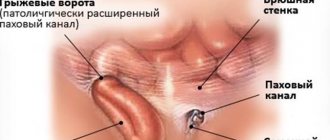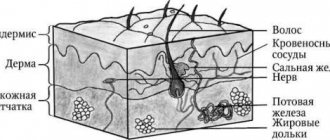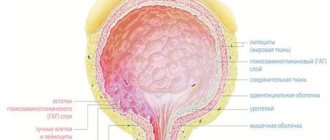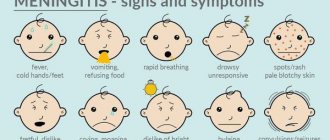17.05.2017
Symptoms of lymphoma in children and the danger of the disease for the child
Lymphoma is a clonal disease of the lymphatic system that develops from a single mutated cell and fills the entire body. The disease often manifests itself in childhood, significantly disrupting a person’s lifestyle, slowing down the child’s development. Without adequate and timely treatment, lymphoma in children leads to death, so it is important to pay attention to the first symptoms and immediately consult a doctor.
The pathological process begins in one of the lymph nodes. For unknown reasons, one atypical cell appears, which, through repeated division, spreads and affects the system responsible for the most important function - immunity.
Only when cancer cells reach a large number do they cause the corresponding clinical picture.
Parents may not pay attention to early symptoms (lethargy of the child, weight loss, increased sweating, painless enlargement of some lymph nodes), which will lead to the loss of precious time necessary for treatment.
What are lymphomas?
Lymphomas belong to the group of hemoblastoses, that is, tumor diseases that develop from blood cells. Conventionally, hemoblastoses include:
- leukemia - with primary localization in the bone marrow
- non-leukemic hemoblastoses - characterized by tumor localization outside the bone marrow. These are non-Hodgkin's lymphoma and Hodgkin's lymphoma.
Non-Hodgkin's lymphoma (NHL) is a malignant disease of the lymphatic system. The name "malignant lymphoma" literally means "malignant enlargement of the lymph nodes." This medical term covers a large group of cancers that begin in the cells of the lymphatic system.
Prevalence of NHL in children:
- In childhood, NHL ranks 3rd among all oncological pathologies, accounting for 5-7%.
- The incidence of the disease in children under 15 years of age is 1:700-750 people. Boys get sick more often than girls. The peak incidence occurs between 3 and 9 years of age.
- NHL is extremely rare in children under 3 years of age.
When should you take your child to the doctor?
- If there is an enlargement of at least one lymph node, which cannot be associated with an infectious process.
- If the child is lethargic, weak, has stopped doing well at school, and sleeps a lot.
- If, while maintaining the same diet, the baby loses weight.
- If sweating is periodically or constantly observed, mainly at night.
- If your body temperature regularly rises and stays at 37.1-37.4.
- If a child has chronic diseases that take a long time to be treated and cannot be put into remission.
Causes of lymphoma development
The disease begins to develop when lymphocytes mutate, that is, they change malignantly. Why this happens is unknown. Lymphocytes are a group of white blood cells that are found primarily in lymphatic tissue. Therefore, non-Hodgkin's lymphomas can appear anywhere there is lymphatic tissue. Most often, the disease develops in the lymph nodes. But it can also develop in other lymphoid tissues and lymphoid organs, for example, the spleen, thymus (thymus gland), tonsils and lymphatic plaques of the small intestine.
Some viruses can cause NHL. A number of studies have established a possible connection between viruses and some forms of NHL.
Course of the disease
The progression of lymphoma is largely determined by the morphology and immunology of the cell that initiated tumor growth.
Thus, if a cell was transformed into a malignant one at an early stage of its development and did not have time to leave the bone marrow, then the result is a picture of predominantly bone marrow tumors (acute lymphoblastic leukemia, lymphoblastic lymphoma).
In cases where the ancestor of the tumor clone becomes a more mature cell of the lymphoid series, which leaves the bone marrow during maturation, the lesion is initially localized in the peripheral lymphoid organs and is characterized by a more favorable course.
Clinical stages of NHL
- Stage I - tumor damage to individual lymph nodes of one anatomical group or damage to one lymphoid tissue. With the exception of damage to the lymphoid tissue inside the chest and in the abdominal space.
- Stage II - tumor involvement of lymph nodes of several anatomical groups or involvement of other lymphoid tissues with local spread and without local spread. But all regions affected by the tumor are on one side of the diaphragm.
- Stage III - tumor damage to the lymph nodes or lymphoid tissue on both sides of the diaphragm. Or the tumor has affected the lymphoid tissue or other organs inside the chest - mediastinum, pleura, thymus, lungs. Also extensive inoperable tumors in the abdominal cavity.
- Stage IV - tumor damage to the central nervous system (CNS) and (or) bone marrow.
Non-Hodgkin's lymphomas in children and adolescents are characterized by rapid progression of the oncological process. The tumor grows so quickly that most children are admitted to the clinic already in stages III-IV of the disease.
However, regardless of the stage of the process, childhood lymphomas have good sensitivity to chemotherapy treatment, which allows up to 80% of patients to be cured.
Get a free consultation
Leading specialists of the Center will answer your questions.
To get a consultation
Find out the price
Lymphomas are a type of malignant tumor that affects the lymphatic system. Non-Hodgkin's lymphomas include all lymphomas except Hodgkin's lymphoma. This group of diseases is very heterogeneous and includes very different course patterns, structures and characteristics.
In the structure of cancer incidence, the share of non-Hodgkin lymphomas (lymphosarcoma) is approximately 3%. In Belarus this figure is slightly lower.
It is worth noting that over the past 10 years there has been an increase in the incidence of NHL in many countries of the world, including Belarus. If in 2001 there were 470 cases, then in 2010 there were already 638, i.e. the incidence increased 1.4 times.
Clinical symptoms of lymphomas
Often the first manifestation of the disease is an enlargement of the lymph nodes, which, as a rule, do not hurt, acquire a rocky density, and merge into conglomerates. Lymph nodes can be detected in the head, neck, arms, legs, armpits, groin areas, chest or abdominal cavities. Often the disease spreads to other organs - the spleen, liver, meninges, bones, bone marrow.
If the tumor is localized in the abdomen, the patient may experience nausea, vomiting, and loss of appetite, which quickly leads to significant weight loss and dehydration. Patients often complain of abdominal pain, and upon examination a large, dense, large tumor is detected. Fig.1. The disease can manifest itself as intestinal obstruction, “acute abdomen” syndrome associated with bleeding, intussusception, perforation of the tumor-affected intestine, which require immediate qualified surgical treatment.
Rice. 1. Nodular formation of the right kidney, merging with a conglomerate of enlarged retroperitoneal lymph nodes - a specific lesion for lymphoma
The liver and spleen are often enlarged.
When the tumor process is localized in the chest, typical complaints include coughing, difficulty breathing and swallowing, and sometimes loss of voice.
A very serious complication that develops with a sharp and significant enlargement of the mediastinal lymph nodes is compression syndrome of the superior vena cava. It is manifested by breathing problems, swelling and cyanosis of the face and neck. The appearance of these symptoms threatens the patient’s life and requires immediate medical attention.
In addition, fluid accumulation may develop in the pleural cavity and pericardial sac, which also quickly leads to respiratory disorders.
The disease can manifest itself with the appearance of complaints of nasal congestion, breathing problems, and the sensation of a foreign body when swallowing, which occurs when the lymphopharyngeal (Waldeyer's) ring is damaged. On examination, there is an enlargement of the tonsils, a tumor hanging from the nasopharynx, which often closes the entrance to the oropharynx. With this localization, enlarged cervical and submandibular lymph nodes are most often found.
When bathing and changing a child, parents may notice the appearance of nodular formations ranging in size from a pea to the size of a walnut, with a dense consistency of flesh-colored or bluish-reddish color with possible ulceration on the surface. This is how soft tissue damage manifests itself in lymphoma. The favorite localization of soft tissue formations is the scalp, anterior chest and abdominal wall, and back.
In boys, the disease can often manifest itself as an increase in the size of the scrotum.
When the central nervous system is damaged, symptoms such as headache, impaired vision, hearing, speech, paresis and paralysis are characteristic.
Primary bone lesions in children and adolescents are rare (2-4%). In this case, the pelvic bones, shoulder blades, and tubular bones are affected with the presence of various sized areas of destruction of the bone structure.
Methods for diagnosing lymphomas in children and adolescents
If a child experiences any of the complaints described above, you should immediately contact your pediatrician. If the child's medical history, a thorough examination, the result of a clinical blood test, as well as an ultrasound and/or x-ray examination suggest non-Hodgkin's lymphoma, the child is referred to a specialized pediatric oncology and hematology clinic.
A comprehensive examination is carried out in a specialized hospital:
- Tumor tissue analysis: examination of a diseased lymph node or other diseased tissue. Samples of the material are obtained surgically. The tumor tissue is sent for cytological, immunological and genetic tests. Based on the results of these studies, we can say for sure whether the child has contracted non-Hodgkin lymphoma, and if so, what type of lymphoma it is.
- Determination of the prevalence of the disease in the body: ultrasound examination of the abdominal organs, retroperitoneal space and pelvis, computed tomography of the chest, abdominal cavity and pelvis, magnetic resonance imaging of the brain and spinal cord (if indicated). To check whether tumor cells have entered the central nervous system, a lumbar puncture is performed - they take the cerebrospinal fluid and examine whether there are tumor cells in it or not. All children also undergo a bone marrow puncture to find out whether malignant cells have entered it or not.
- To assess heart function, electrocardiography and echocardiography are performed.
- Comprehensive laboratory tests: clinical blood tests, urine tests, biochemical blood test with assessment of kidney and liver function, determination of uric acid, electrolytes, lactate dehydrogenase (LDH), study of the blood coagulation system (coagulogram), determination of blood group and Rh factor.
Modern treatment programs for non-Hodgkin's lymphomas in children are based on an individual approach, taking into account various morphological and clinical variants of the disease.
charitable foundation
The essence of the disease
Lymphoma is a malignant tumor disease of the lymphatic system. Lymphomas include Hodgkin's lymphoma and all other types of lymphomas - non-Hodgkin's lymphomas (NHL). When people simply say “lymphoma,” they most often mean non-Hodgkin’s lymphoma.
In lymphoma, the tumor consists of lymphoid cells (mature or precursor cells), which form clusters in the lymph nodes, as well as in internal organs: spleen, stomach, intestines, lungs, central nervous system (brain and spinal cord), etc.
There are many types of NHL, varying in nature: according to the World Health Organization classification, there are several dozen of them. For treatment and prognosis, it is especially important to divide lymphomas into indolent (sluggish), that is, relatively slowly progressing even in the absence of specific treatment, and aggressive, that is, rapidly developing. Children and adolescents suffer almost exclusively from aggressive lymphomas, which determines the tactics of their treatment.
Based on the type of lymphoid cells from which the tumor arises, B-, T- and (rarely) NK-cell lymphomas are distinguished. Most lymphomas are B-cell.
The “spectrum” of childhood NHL has its own characteristics: as already mentioned, we are usually talking about rapidly progressing aggressive lymphomas, and the tumor process often involves the bone marrow and/or the central nervous system. At the same time, lymphomas in children usually respond well to therapy. The most common NHLs found in children and young adults include Burkitt's lymphoma (an aggressive B-cell lymphoma), diffuse large B-cell lymphomas, lymphoblastic lymphomas (usually T-cell lymphomas), and anaplastic large cell lymphoma.
As in the case of Hodgkin lymphoma, NHL is divided into four stages, depending on the extent of the process. But to determine the stage of NHL in children, a modified scale developed by Murphy (St. Jude Hospital, USA) is usually used. Thus, stage IV of the disease on this scale is considered to be NHL involving the bone marrow, central nervous system and/or damage to the skeletal bones.
Since in lymphomas the tumor consists of cells of a lymphoid nature, some NHL may be close to acute lymphoblastic leukemia in terms of the characteristics of the tumor cells and treatment strategy. However, with leukemia, unlike lymphoma, the malignant process primarily affects the bone marrow. Sometimes it is difficult to draw a clear boundary between leukemia and lymphoma, and then the detection of 25% lymphoblasts in a myelogram (that is, when examining the cellular composition of a bone marrow sample) is usually taken as a conditional threshold value: if there are fewer of them, then it is lymphoma, and if there are more, then lymphoblastic leukemia.
Frequency of occurrence, risk factors
The total incidence of all types of NHL in European countries is 12-15 cases per 100 thousand population per year. The risk of NHL increases with age, and in children non-Hodgkin's lymphoma is relatively rare: no more than 5% of all NHL cases occur in childhood and adolescence. However, lymphomas still occupy third place in the structure of malignant diseases of childhood - after leukemia and tumors of the central nervous system. Boys get sick more often than girls; Preschool children rarely get sick.
The likelihood of NHL, like many other cancers, is increased in people who have previously received radiation for other tumors or have been exposed to carcinogens. Patients with congenital (Wiskott-Aldrich syndrome, Nijmegen syndrome, ataxia-telangiectasia, etc.) or acquired immunodeficiency conditions are also at risk.
Epstein-Barr virus infection is associated with an increased risk of various types of lymphoma, including Burkitt's lymphoma.
Signs and symptoms
In aggressive childhood lymphomas, the primary tumor can occur in a variety of areas of the body, including central areas. Symptoms of the disease depend on the primary location of the tumor and its extent. They can grow very quickly, causing the need for immediate hospitalization of the patient.
Thus, the tumor often occurs in the mediastinum, that is, in the middle parts of the chest cavity (in particular, this is typical for lymphoblastic T-cell lymphomas), and can affect all groups of lymph nodes in this area. In this case, symptoms such as a feeling of pressure and fullness in the chest, difficulty swallowing, shortness of breath, and bluish skin (cyanosis) may be observed. Such patients require urgent hospital treatment.
In childhood B-cell NHL, the primary tumor most often occurs in the abdominal cavity. Damage to the intestines and/or intra-abdominal lymph nodes is observed. In this case, the first symptom is abdominal pain, an increase in its volume, and often the development of intestinal obstruction, which requires urgent surgical intervention.
Specific symptoms may occur with lymphomas affecting the pharyngeal ring: the timbre of the voice changes, the tonsils enlarge.
When peripheral lymph nodes (cervical, supraclavicular, axillary, inguinal, etc.) are affected, they become enlarged and dense, but are painless.
As damage to various organs progresses, other specific signs may appear. Thus, when the central nervous system is involved in the tumor process, neurological symptoms may occur, including seizures, partial paralysis, and visual impairment. Sometimes there are signs of damage to the bones, nasopharynx, etc.
Possible “general” symptoms of lymphoma include weakness, weight loss, and sometimes fever not associated with an infectious process.
Diagnostics
When diagnosing NHL, it is important not only to detect the presence of lymphoma, but also to determine its specific variant, since treatment and prognosis depend on this.
If lymphoma is suspected, an urgent examination is performed, including a biopsy of tumor foci. Morphological and immunohistochemical studies of the sample can distinguish NHL from Hodgkin lymphoma and more accurately determine the specific type of NHL. Additional research methods used in some cases include cytogenetic and/or molecular genetic tests.
To understand whether the tumor process affects the bone marrow (and if so, to what extent), a bone marrow puncture is performed, followed by analysis of the resulting sample. Damage to the central nervous system can be confirmed or excluded by using a puncture of the spinal canal with analysis of the cerebrospinal fluid for the presence of tumor cells.
In addition, imaging studies are required to assess the extent of the tumor process. So, to identify enlarged mediastinal lymph nodes, chest x-ray is used, and computed tomography (CT) is needed to clarify the information. To assess the condition of the abdominal organs, retroperitoneum and pelvis, ultrasound (US), CT and positron emission tomography (PET) are used.
Routine laboratory tests are also carried out, including a clinical blood test. In a biochemical blood test, the level of lactate dehydrogenase (LDH) is especially important, which can serve as an indicator of tumor activity and be used in determining the required amount of treatment.
Treatment
Aggressive lymphomas respond better to therapy than indolent lymphomas and in many cases can be cured completely, especially if diagnosed early. The main treatment method for aggressive lymphomas is polychemotherapy, while radiation therapy and surgical treatment are of secondary importance. This is due to the fact that aggressive NHL is not a local, but a systemic process, and therefore therapy should be aimed not so much at a specific affected area, but at the body as a whole.
Since the characteristics of tumor cells in different types of lymphoma differ from each other, the treatment methods for different NHLs should also differ. For example, in children, different approaches are used to treat B-cell lymphomas (such as Burkitt's lymphoma), T-cell lymphoblastic lymphoma, and anaplastic large cell lymphoma. This is partly what explains the advances achieved in the treatment of NHL in childhood and adolescence over the past 20 years.
There are a number of intensive chemotherapy protocols for the treatment of various types of NHL - for example, protocols based on modifications of the developments of the German-Austrian BFM group, and some others, are widely used.
Treatment of B-cell lymphomas, which include most lymphomas in children and young people, usually involves several short, intensive courses of polychemotherapy with high doses of chemotherapy; The duration of treatment is 2-5 months. Intrathecal therapy is also performed to prevent damage to the central nervous system. In addition to cytotoxic drugs, rituximab (MabThera) has been successfully used in the treatment of B-cell NHL in recent years; This drug belongs to the class of monoclonal antibodies and provides a specific effect on B lymphocytes.
Treatment of lymphoblastic lymphoma in children is very similar to the treatment of acute lymphoblastic leukemia: courses of induction of remission and consolidation are carried out, reinduction courses are also used and, possibly, intrathecal therapy for the treatment and/or prevention of damage to the central nervous system. Intensive hospital treatment is followed by a long period of maintenance therapy. The total duration of treatment is up to 2-3 years.
Doctors' arsenal also includes new drugs. Thus, in many cases of anaplastic large cell lymphoma that do not respond well to standard therapy, brentuximab vedotin (Adcetris) or crizotinib (Xalkori) can help.
Intensive chemotherapy for lymphomas can lead to various complications. One of the most dangerous among them is tumor lysis syndrome, a complex of metabolic disorders associated with the death of a large number of tumor cells. This can lead to severe damage to organs, especially the kidneys. Infectious complications due to decreased immunity are also common. Therefore, careful monitoring of the patient’s condition, prevention of complications and their relief are necessary.
If standard therapy is ineffective or if the disease relapses, bone marrow transplantation may be used, especially in young patients. If the bone marrow is not involved in the tumor process, then an autologous transplantation is most often performed, otherwise (and in the presence of a compatible donor) - allogeneic, that is, from a donor. Unfortunately, recurrence of lymphoma usually means a worsening prognosis, and in some variants of the disease, a very significant one.
Forecast
Aggressive types of lymphoma without treatment lead to the rapid death of the patient. However, modern methods of therapy can achieve high patient survival. According to developed countries, over 80% of children and young people with various types of aggressive NHL can achieve complete recovery.
An important role is played by timely diagnosis and rapid initiation of therapy specific to a particular type of NHL, as well as compliance with strict rules of accompanying therapy, prevention and treatment of infections.
General principles of treatment of non-Hodgkin lymphomas
- For stages I and II of the disease, less intensive chemotherapy is used.
- For all types of NHL in children, prevention of damage to the central nervous system is mandatory.
- During intensive program polychemotherapy of mature cell lymphomas in children, radiation therapy is not indicated.
- Polychemotherapy is carried out against the background of a complex of adequate accompanying therapy.
Causes of NHL
The root cause of the development of the oncological process is currently unclear. There are factors that provoke the occurrence of the disease:
- viral and bacterial infections (mainly Epstein-Barr virus, HIV, hepatitis virus, H. pylori and other infectious agents);
- prolonged contact with carcinogenic substances;
- taking cytostatics;
- episodes of radioactive exposure;
- history of autoimmune diseases (systemic lupus erythematosus, thyroiditis, multiple sclerosis);
- genetic (congenital) disorders (Klinefelter syndrome);
- family history (presence of the disease in close relatives).
Treatment of mature T- and B-cell lymphomas
For the treatment of mature cell lymphomas, strict but short-term treatment (up to six months) is used using high-dose chemotherapy and immunotherapy (Fig. 2).
Treatment is carried out in short intensive courses - from 2 to 6. Their number depends on the stage of the disease and the risk group of the child. To determine the risk group, parameters such as the radicality of the operation (if any), the size and location of the tumor, the level of LDH in the blood and damage to the bone marrow and central nervous system are taken into account.
For the treatment of mature B-cell lymphomas, the cells of which express the CD20 antigen, the targeted drug rituximab (Mabthera, Acellbia) is used.
Rice. 2. NHL-BFM protocol for the treatment of mature B-cell lymphomas
Treatment of lymphoblastic lymphomas from T- and B-precursors
Treatment of children with lymphoblastic lymphoma is long-term, continuous for 2 years. It consists of several successive phases: prophase, induction - protocol I, consolidation - protocol M, reinduction - protocol II, prevention of damage to the central nervous system. Rice. 3.
To prevent damage to the central nervous system, the introduction of chemotherapy into the spinal canal and radiation therapy are used. Maintenance therapy is carried out for 1.5 years.
The intensity of the treatment program depends on the stage of the disease.
Rice. 3. NHL-BFM protocol for the treatment of lymphoblastic lymphomas from T- and B-precursors
Prognosis and prevention of large cell lymphoma
The prognosis for diffuse large B cell lymphoma depends on the IPI score. The higher the score, the worse the prognosis. For patients with a score of 4-5 (high risk), the five-year survival rate ranges from 31%. At low risks, the five-year survival rate is about 91%.
As for specific prevention, it does not exist today, and all recommendations for minimizing the risk of the disease boil down to maintaining a healthy lifestyle and proper nutrition.
Book a consultation 24 hours a day
+7+7+78
Clinical observation for NHL
Dynamic observation of children and adolescents is carried out for at least 3 years after completion of the treatment program.
In the first 3 months, the patient is examined every month, in the next 9 months - every quarter, then every six months.
The examination includes an examination of the patient with an assessment of complaints, clinical and biochemical blood tests with determination of LDH, ultrasound of the primary lesion, chest X-ray, and CT/MRI is used if indicated.
In recent years, whole body PET/CT with glucose has become widespread for dynamic monitoring of cured patients for the purpose of early diagnosis of relapse.
Diagnosis of diffuse large cell lymphoma
The diagnosis of non-Hodgkin lymphoma is made on the basis of histological and immunohistochemical examination of tumor tissue. In order to obtain material, an incisional or excisional biopsy of the lymph nodes is performed. In addition, molecular genetic and immunophenotypic studies are performed, which will help determine the type of tumor, the presence of certain genetic changes and select the optimal treatment method.
To determine the stage of lymphoma, the following studies are performed:
- Trephine biopsy of bone marrow.
- Radiation diagnostic methods - ultrasound, CT, PET-CT, MRI.
- A number of laboratory tests are also prescribed - a complete blood count, determination of markers of parenteral hepatitis, HIV testing, biochemical studies, etc.









